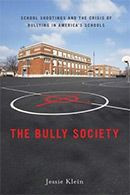The Bully Society: School Shootings and the Crisis of Bullying in America’s Schools

Author: Jessie Klein
New York: New York University Press, 2012. 318p.
Reviewer: Lisa De La Rue | July 2012
Concerns about the safety of schools and the exposure of children to violence have spurred national debates and calls to reform the environments in which our youth find themselves. In The Bully Society, Jessie Klein proposes that there are inextricable connections between school shooting outbursts and the everyday violence of bullying, and the destructive gender pressures and social demands created by the larger culture. Her book describes how the pressures and demands have influenced youth, as well as the role they have played specifically in school shootings.
While there have been a substantial number of school shootings, they still tend to be regarded as aberrations and isolated incidents. Klein makes the argument that instead of being aberrations, these incidents are more appropriately viewed as being extreme reactions to the sorts of violence and harassing behaviors that so many young people deal with on a daily basis. Her argument is buttressed by a systematic review and analysis of press and research reports pertaining to the 166 school shootings that took place in the decades between 1979 and 2009. Klein utilizes this information along with her extensive experience as a social worker in U.S. schools in order to present a clear and compelling explanation for the rise of school violence and shootings. She then explores ways to improve the school environments and offers suggestions as to how and where schools can intervene.
Klein focuses on three key characteristics of the school culture in particular: gender policing, masculinity imperatives, and normalized bullying. These factors, she says, all contribute to a school culture that facilitates the everyday bullying behavior and violence to which youth are exposed. They are also common themes in the history of school shootings.
Klein leads the reader through a detailed discussion of the role of gender pressures, including an explanation of the way gender expectations play out for youth. Gender norms in society, and in particular masculinity expectations, encourage a “subtle and pervasive pattern of violence” (45). These gender expectations, she believes, emphasize that privileges related to masculinity — power, domination and violence — are desired and to be sought, especially by boys. Young men are expected to strive for these masculine ideals and are rewarded for behaviors that demonstrate masculinity. When boys show any deviation from the masculine ideal and display traits that may be associated for any reason with femininity, they are at risk of ridicule from their peers.
The author presents some theories of masculinity and describes how schools and society set up gender expectations that influence the masculine ideals. When young men feel they do not possess these masculine traits, they may fear for their identity and have a sense of lacking power and status. Many of the school shooters expressed these feelings of being ignored or powerless, and saw violence as a means to demonstrate their masculinity and power.
In this context of gender issues, the author looks specifically at violence against girls and women, and argues that this violence has often been ignored or downplayed when looking at school shootings. Schools are struggling to deal appropriately with incidents of sexual harassment and teen dating violence, but often tend to under react or not respond at all. This lack of response to relatively “low levels” of harassment may end up obscuring the warning signs that can lead to more severe school violence. Many of the school shooters expressed frustration with girls who had rejected them, and saw violence as a means to take revenge and demonstrate feelings of masculinity. In environments that facilitate the demeaning treatment of women, including subjecting them to harassment and abuse, such harassment and abuse may become a prerequisite to proving manhood and achieving status and popularity (78).
Further with respect to gender expectations, Klein describes so-called “gay bashing,” as well as “girl bashing.” She says, “[m]asculinity expectations in the form of heterosexism are a crucial but under examined motivation for school shootings and school violence generally” (82). Many of the perpetrators of school violence were constantly teased about their perceived homosexuality, despite the fact that most of the youth were actually heterosexual. This homophobic teasing is intended to convey that the student being teased is less of a man and is less powerful. Klein argues that school shooters might have viewed their extreme acts of violence as the ultimate way to send the message that they were indeed masculine and powerful.
Many of the school shooters were targets of repeated bullying and harassment — experiences that moved beyond the school environment. Much of the bullying behavior that students experience now occurs across multiple domains, including on the internet, and via text messaging and other media.
Adults, including teachers, administrators and parents, are also a part of the school community, and they obviously greatly influence the school culture. In some instances, these adults may actually be the perpetrators of the bullying that victims experience. Even more likely, teachers and other adults may not intervene on behalf of bullying victims. In fact, many of the school shooters indicated that a lack of adult support or intervention exacerbated the bullying they experienced at school. “They were left largely on their own to deal with the humiliation, exclusion, and violence they faced daily at school” (127). Thus, many of the school shooters expressed frustration with having to fend for themselves in an environment where bullying and hazing were perceived as normal, and where adults did little to intervene.
Klein explores the difference in responses to violence between American schools and European schools. American schools tend to respond to violence by increasing protection through security and punishment. In contrast, European schools respond by building up the community and working to improve relationships. European responses to violence have focused less on restricting students and faculty, and more on supporting the development of meaningful relationships in schools. While seemingly well-meaning, the increased limitations and security efforts implemented in U.S. schools have not actually made students safer. Instead, Klein believes, when we turn schools into high security facilities with police and metal detectors, we are more likely to fuel the frustration of students who already feel abused by their peers and the larger society (192).
Klein recommends that efforts other then control and increased restriction need to be explored in order to deal with school violence. Among these efforts is building a community where bullying behavior is not tolerated, and where individuals in the community are expected to support one another (198). She describes school-based programs along these lines that have been successful in reducing incidents of bullying.
This book provides a comprehensive overview of the concerns about and the contributing factors to school violence, and in particular to school shootings. The author gives us a number of suggestions on possible areas of intervention — changes that can be made in schools in an effort to counteract school violence. Jessie Klein makes a great case here for why these suggestions ought to be heeded.
Lisa De La Rue is a Counseling Psychology Doctoral Student, University of Illinois Urbana-Campaign


